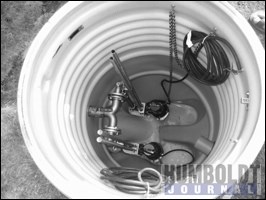The City is encouraging residents to help reduce the risk of basement flooding by initiating the storm water rebate policy.
The program gives residents a rebate when they install a backflow valve, sump pit, weeping tile, or fix their previously improper installation.
"We want to get any type of groundwater that goes into the sanitary sewer out of there and pump that water outside because it's only storm water," said Peter Bergquist, director of planning & engineering. "If it remains flooded in the sewer, the backflow valve keeps your basement from getting flooded."
The issue is this: for homes that don't have a sump pit, or it's not properly installed, all the water that's collected from both the house drainage (e.g., from the tubs and sinks) and the weeping tiles goes into the sanitary sewer pipe. If only a few houses do this, it's not too much of a problem, but when many houses are doing this, it overloads the sewer system.
This can cause a few different problems for both the city and residents.
"If you're just putting that water down into the sanitary sewer, (water treatment plants) have to run longer, lagoons need to have more storage for all that water and longer treatment times," said Bergquist. "Rainwater doesn't need to be treated, but it puts more demands on the lagoon system. These installations are the most economical way to lower the issues and save all us taxpayers money so we don't' have to keep it as large."
However, there's a tiny catch in this solution. Depending on the design and construction of the house, installing this system could end up costing certain residents a fair amount of money. There are different criteria that come into play, making it more difficult and more expensive for some people.
"The cost of installing the sump pit depends on how much labour is involved in digging out the concrete," said Jerry Kielen on behalf of Reliable Plumbing & Gas Fitting Ltd. "The concrete has to be jackhammered out and you have to dig out the stuff around the (sanitary) pipe. Then after the work is done, someone has to repour the cement."
According to Kielen, the criteria usually entails where the main sewer line is, where it goes, the depth of it, the accessibility, and how much room there is to work with. It will also depend on if it's out in the open or if there are walls or partitions and whether or not the floors and walls are finished.
"Some of the older houses aren't finished, but the newer ones are covered in carpet," said Kienlen. "We can take it out, but you got to hire someone to put it back in. We can give you an estimate for the excavation."
Despite these initial costs, there's also an added benefit aside from the reduced risk of basement flooding and lower taxes.
According to Kienlen, some insurance companies won't give insurance against basement flooding if the sump pit isn't installed or if they did, the deductible would be considerably higher. Those conditions might also depend on how much water there is below the basement and if it's flooded before.
Thus, the benefits and safety net provided by the sump pit installation might outweigh the initial costs of installation. For those residents who might have an improperly installed sump pit (whereby rainwater is still being directed directly into the sanitary pipe), the work is already half done. They just need to install a rigid pipe that redirects rain and groundwater outside.
Moreover, as the city continues to grow, so will the stress on the system and the need to continually upgrade the systems.
"The sump pits are meant to collect water and then take it outside," said Bergquist. "I don't know if it was incorrectly installed, if that was an 'oops' in the house, but it's meant to collect water. That's its sole purpose."
While the storm water rebate policy isn't new, the changes to the values of the rebates are.
"This new rebate policy went up in dollar money for how much money you get back," said Bergquist. "We did have it in place, but now we're getting a bit more aggressive by updating prices and trying to get more participation."




